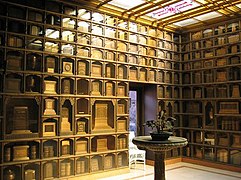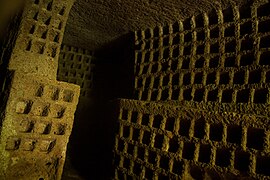Columbarium

A columbarium (/ˌkɒləmˈbɛəri.əm/;[1] pl. columbaria), also called a cinerarium, is a structure for the reverential and usually public storage of funerary urns holding cremated remains of the dead. The term comes from the Latin columba (dove) and originally solely referred to compartmentalized housing for doves and pigeons, also called dovecotes.
Background
[edit]Roman columbaria were often built partly or completely underground.[2] The Columbarium of Pomponius Hylas is an ancient Roman example, rich in frescoes, decorations, and precious mosaics.[3]
Today's columbaria can be either free standing units, or part of a mausoleum or another building. Some manufacturers produce columbaria that are built entirely offsite and brought to a cemetery by large truck. Many modern crematoria have columbaria. Examples of these are the columbaria in Père Lachaise Cemetery in Paris and Golders Green Crematorium in London.
In other cases, columbaria are built into church structures. One example is the Cathedral of Our Lady of the Angels (Los Angeles, California), which houses a number of columbarium niches in the mausoleum built into the lower levels of the Cathedral. The construction of columbaria within churches is particularly widespread in the Czechoslovak Hussite Church. An example can be seen at the Church of St Nicolas in Old Town Square (Prague). In the Roman Catholic Church, although traditional burial is still preferred, cremation is permitted provided that the cremated remains are entombed and that the cremation is not done for reasons contrary to the Catholic faith. As a result, they are within some Catholic cemeteries.
Columbaria are often closely similar in form to traditional pagodas which function as in-situ columbaria pavillions at Buddhist temples, which from ancient times have housed cremated ashes. In Buddhism, ashes may be placed in a columbarium (in Chinese, a naguta ("bone-receiving pagoda"); in Japanese, a nōkotsudō ("bone-receiving hall"), which can be either attached to or a part of a Buddhist temple or cemetery. This practice allows survivors to visit the temple and carry out traditional memorials and ancestor rites.
Gallery
[edit]-
Columbarium wall, with flowers, plaques, and empty niches
-
Detail of the columbarium at Père Lachaise Cemetery, Paris
-
A modern columbarium in a small town (Ebingen, Germany)
-
Interior of columbarium at Chapel of the Chimes in Oakland, California. Some of the cinerary urns are book-shaped.
-
Columbarium at Arlington National Cemetery in Virginia. Each niche is covered with a marble plaque.
-
Columbarium and Funerary Chapel, Episcopal Church of the Good Shepherd (Rosemont, Pennsylvania), United States
-
A traditional Japanese columbarium at the Takidani Fudōmyō-ō Temple, Osaka, Japan
-
A modern Chinese-style columbarium at Nan Tien Temple in Wollongong, Australia
Caves in Israel
[edit]
In the Beit Guvrin area several series of large caves dug into soft rock were found. There were several theories about their original use, for ritual burial, for growing pigeons to be used for ritual sacrifice, or for raising pigeons for fertilizer production. One such cave had been covered by an earthquake close to the time of its original usage and had no signs of secondary usage; neither ashes nor pigeon droppings were found in it.[4][5]
See also
[edit]References
[edit]- ^ "Definition of 'columbarium'". Collins English Dictionary. HarperCollins Publishers. Retrieved 8 February 2019.
- ^ Toynbee, J M C (1971). Death and Burial in the Roman World. Johns Hopkins University Press. pp. 113–118. ISBN 9780801405938.
- ^ Ancient Roman underground columbariums included: Columbarium of Statilii, Columbarium of Volusii, Columbarium of Livia, Columbarium of Pomponius Hylas, Columbarium of Lucius Arruntius, Columbarium of Iunius Silanus, Columbarium of Nero Claudius Druscus, Columbarium of Marcella, Columbarium of Carvilii, Columbarium of C. Annius Pollio, Columbarium of Caecilii, Columbarium of Passienii, Columbarium of Bruttii, Columbarium of L. Caninius Gallus, Columbarium of L. Abucii, Columbarium of Q. Sallustii. Further reading in Pavia, Carlo. Guide to Underground Rome: From the Cloaca Maxima to the Domus Aurea: the Most Fascinating Underground Sites of the Capital. English translation by Darragh Henegan. Rome: Gangemi, 2000. ISBN 88-7448-994-3
- ^ "Bet Guvrin National Park". Israel National Parks. Archived from the original on 2016-10-18. Retrieved 2016-10-14.
- ^ "The Land of 1000 Caves". israel21c.org. 2014-09-03.
External links
[edit]Text is available under the CC BY-SA 4.0 license; additional terms may apply.
Images, videos and audio are available under their respective licenses.









